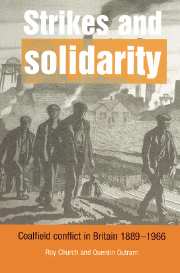Book contents
- Frontmatter
- Contents
- List of figures and tables
- Preface
- List of abbreviations
- 1 Interpreting coalfield conflict: focus and formulations
- 2 Tradition and modernity: the mining industry 1889–1940
- 3 Employers and workers: organizations and strategies
- 4 Employers and workers: ideologies, attitudes and political orientations
- 5 Configurations of strike activity
- 6 Strike participation and solidarity before 1912
- 7 Strikes, organization and consciousness in 1912 and after
- 8 Conflictual context? The ‘isolated mass’ revisited
- 9 Mining and modernity: size, sectionalism and solidarity
- 10 The foundations of strike propensity
- 11 Miners and management: agency and action
- 12 Industrial relations and strikes after nationalization
- 13 International perspectives
- 14 Myths and realities: strikes, solidarity and ‘militant miners’
- General appendix
- List of references
- Index
10 - The foundations of strike propensity
Published online by Cambridge University Press: 04 December 2009
- Frontmatter
- Contents
- List of figures and tables
- Preface
- List of abbreviations
- 1 Interpreting coalfield conflict: focus and formulations
- 2 Tradition and modernity: the mining industry 1889–1940
- 3 Employers and workers: organizations and strategies
- 4 Employers and workers: ideologies, attitudes and political orientations
- 5 Configurations of strike activity
- 6 Strike participation and solidarity before 1912
- 7 Strikes, organization and consciousness in 1912 and after
- 8 Conflictual context? The ‘isolated mass’ revisited
- 9 Mining and modernity: size, sectionalism and solidarity
- 10 The foundations of strike propensity
- 11 Miners and management: agency and action
- 12 Industrial relations and strikes after nationalization
- 13 International perspectives
- 14 Myths and realities: strikes, solidarity and ‘militant miners’
- General appendix
- List of references
- Index
Summary
Alternative models of coalfield conflict
Only two strong quantitative hypotheses have been formulated to explain the high level of strike propensity among coalminers: the Kerr–Siegel hypothesis and Revans's ‘size effect’ idea (chapters 8 and 9). In chapter 8 we found that insofar as Kerr and Siegel's hypothesis was successful, its incorporation of massness in the workplace was as important as its treatment of massness in the locality. These two hypotheses are therefore closely linked. We were critical of both, yet we also concluded that each possessed some potential to contribute towards clarifying which were the key factors. We investigated the collieries contained in a random sample of English and Welsh colliery areas in the inter-war period, and found that of large-scale collieries in areas dominated by mineworkers more than a quarter were strike-prone as measured by the number of working days lost and almost half as measured by the number of strikes (table 8.2). Our investigation of the size effect in a sample of British collieries in the same period confirmed the importance of colliery size, indicated the importance of understanding solidarity in understanding strikes and enabled us to put forward an explanation of why colliery size was associated with strike activity.
Although the insights we have gained from these two hypotheses are very useful the fact remains that their joint explanatory power remains disappointingly low. Some collieries that were neither isolated nor large were nevertheless strike-prone; a much larger number of collieries were isolated and large but not at all strike-prone.
- Type
- Chapter
- Information
- Strikes and SolidarityCoalfield Conflict in Britain, 1889–1966, pp. 173 - 195Publisher: Cambridge University PressPrint publication year: 1998



